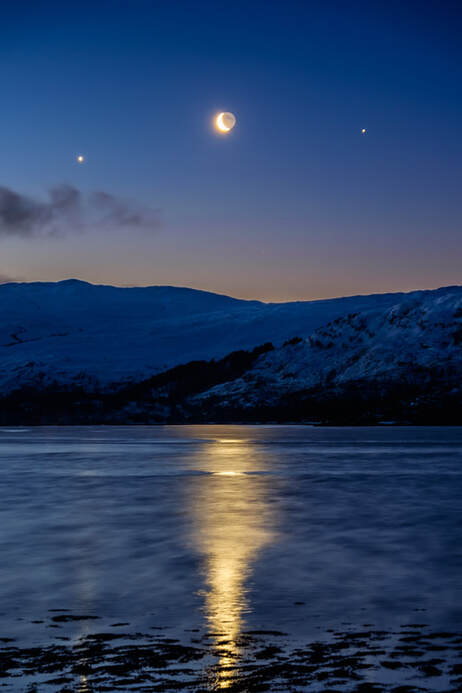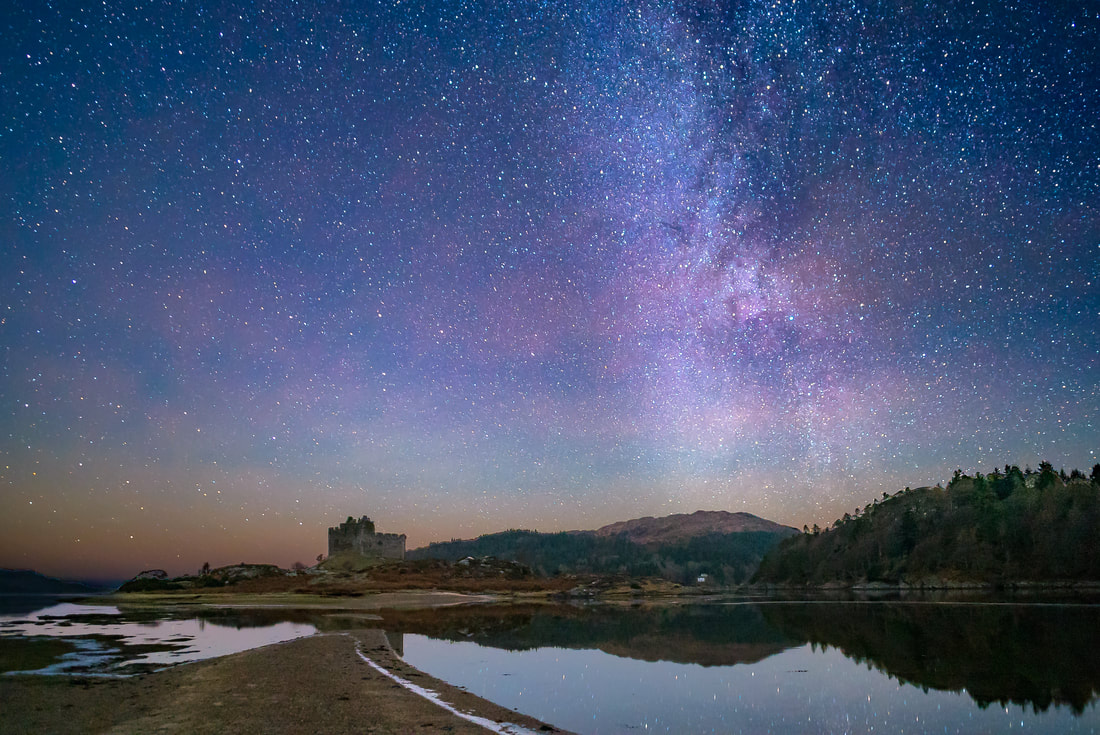|
The image below shows a full Moon way out beyond the entrance of Kentra Bay, hanging in the sky above the Isle of Eigg and the snow-capped peaks of the Rùm Cuillin in the hour or so before it was due set in the north-west. Taken on the extremely cold morning of 30 December 2020 and showing the last full Moon of the year, I decided to call the image “Cold Last Moon I” only to later find out that I was indeed looking at a Cold Moon. The names of full Moons come from early Native American culture because many tribes tracked the passage of time by using each full Moon and linking its name to the changes in the natural world as the months passed. In 2024, the names and timing of the full moons will be follows: Wolf Moon: 25 January at 5:54 pm This name originates from the howling of wolves that was often heard during the cold January nights. It symbolises the harshness of winter and the challenges faced by both humans and wildlife. Snow Moon: 24 February at 12:30 pm February tends to bring heavy snowfall in many regions, so this Moon was named after the deep snow covering the ground and reflects the often challenging weather conditions of midwinter.
Buck Moon: 21 July at 11:17 am July is the month when the new antlers of buck deer grow larger. This full Moon was named in recognition of this phase of antler growth, indicating the maturity and strength of the bucks. Super Sturgeon Moon: 19 August at 7:25 pm August was associated with the abundance of sturgeon fish in lakes and rivers of North America and the Sturgeon Moon acknowledges the significance of this large fish in the ecosystems during this time. Super Harvest Moon: 18 September at 3:34 am This is the full Moon closest to the autumnal equinox. Its name comes from the extra light it provides during the evenings, allowing farmers more time to harvest their crops as the days shorten. Super Hunter’s Moon: 17 October at 12:26 pm
Following the Harvest Moon, the Hunter's Moon was associated with the time to hunt and prepare for winter. It provides additional light for hunters pursuing game in the waning light of autumn. Super Beaver Moon: 15 November at 9:28 pm November is when beavers actively build their winter dams in preparation for the colder months and the Beaver Moon recognises this industrious activity. Cold Moon: 15 December at 9:01 am As December brings the coldest temperatures of the year in many places, the Cold Moon emphasises the chill in the air and the onset of winter's full force. You’ll also see that four of the full moons will be supermoons. It’s when the Moon is at its closest to us in its elliptical orbit and will appear bigger and brighter than normal, so do look out for them then.
4 Comments
From early July to late September, we have been treated to the sight of four full supermoons rising in the east at sunset and with two full supermoons happening in August, much was made of them on the television and radio and in the newspapers. In addition, social media was full of people’s photographs of what were truly magnificent spectacles. However, something that we hear a lot less of is the rising or setting of a crescent moon which, in my opinion, is a far more beautiful and beguiling sight and one that has deep symbolic significance in various cultures and spiritual traditions around the World The beauty of a crescent moon is very subjective and is very much down to personal preference, but I do find it particularly captivating when the Moon is visible at sunset or sunrise. This timing allows a crescent moon to appear against the backdrop of the colourful twilight sky and create a striking visual contrast just like it did on the evening when I took this month’s photograph. I was absolutely captivated by the sight of it hanging in the sky just above the hills of Morvern and the orange glow from a setting Sun.
This captivating and beautiful celestial sight has been historically associated with various myths and cultural beliefs and predominant themes seem to be ones of renewal and transformation. In various religious contexts, a crescent moon holds specific meanings. In some pagan and Wiccan traditions, the crescent moon is considered a symbol of the feminine divine, representing cycles, intuition, and the ever-changing nature of life, while in Hinduism, it is associated with various deities, including Shiva and Parvati and the waxing and waning of the Moon is said to represent the cycle of life, death, and rebirth. However, it is in Islam where the crescent moon perhaps features most prominently and is seen on top of minarets and mosques, and on the flags of many Muslim countries. Representing the beginning of the lunar month, it is used to determine the timing of important Islamic events and holidays, such as Ramadan, the ninth month of the Islamic lunar calendar. This month is a time of fasting, prayer, reflection, and community for Muslims worldwide and the crescent moon plays a crucial role at its beginning and end. The sighting of the new crescent moon marks the end of the month of Sha'ban and the beginning of Ramadan, while the sighting of the crescent moon at the end of Ramadan signifies the end of the fasting period and the celebration of Eid al-Fitr, a festival that marks the end of Ramadan. Given how captivating the sight of a crescent moon can be, it is perhaps little wonder that it plays a role in several of the World’s cultures and religions, but whatever your beliefs are, it is certainly a sight worth seeing. So, if you are an early riser, look out for it in the east at sunrise on the mornings just before a new moon and if you are a night owl, look for it in the west at sunset a few days later. You won’t be disappointed.
When you hear someone say, "Once in a blue moon …" you probably think that they are talking about something rare. In fact, this month’s image shows the blue moon of October 2020 sitting above the summit of Càrn na Nathrach in Ardgour, with the peaks of Druim Garbh, Sgùrr Dhomhnuill and Sgùrr na h-Ighinn to its left. So, what exactly is a blue moon and is it actually that rare? Most people will have watched a white coloured moon traversing the night sky and some people may have even seen a yellow or red moon at moonrise or moonset. On the other hand, very few people will have seen a blue coloured moon because it is a very rare occurrence indeed.
This rare event, when the Moon can naturally appear blue, is caused by the presence of dust particles in the atmosphere which, if they are the right size, can scatter the red part of the light spectrum and leave the rest untouched to cause the moon to take on a blue tint. Some of the events that have led to this include the eruption of Krakatoa in 1883 and the eruptions of Mount St. Helens in 1980 and the El Chichón volcano in Mexico in 1983. In fact, the eruption of Krakatoa reportedly caused blue moons for nearly 2 years. However, the bluish tint caused by these rare events doesn’t have anything to do with the phrase “once in a blue moon”. Instead, the words ‘blue moon’ are used to describe the second full moon in a calendar month. It is an event that is not that rare because there are 29.5 days between full moons, meaning that each year will have roughly 12.3 full moons. This gives us a 13th full moon once every 2.7 years, along with a month within which a second full moon, or blue moon occurs. In fact, the last blue moon to occur was the one that is shown in the image above, which I photographed in October 2020. The next one is in August 2023 and the one after that will be in May 2026. Considerably rarer than blue moons are double blue moons. This is when there are two blue moons in the same calendar year, and it is something that occurs about 3-5 times every hundred years of so. The last one was in 2018, the next is expected in 2037 and the one after that in 2067. Rarer still is what is termed a super blood blue moon. This is when a blue moon occurs when the Moon comes within 90% of its closest distance to Earth to make it a supermoon, while at the same time fully slipping into the Earth’s shadow to create a total lunar eclipse. This last happened in January 2018, just over 150 years since all three phenomena last lined up in March 1866. If you look at the frequency at which these three phenomena are expected to occur;
meaning that a super blood blue moon will occur 0.042% of the time, or once every 2,381 full moons. On average, that corresponds to once every 194 years! So, the next time you think about using the phrase “once in a blue moon” for something that almost never happens, you might want to consider using “once in a super blood blue moon” as an alternative!! Most people will be aware that the moon and the sun are primarily responsible for the rising and falling of the ocean tides, with the difference in height between high and low tides varying through the month as the Moon waxes and wanes from new to full and back to new again. They’ll also be aware that spring tides are not those that occur in Spring, but instead are the highest (and lowest) tides that occur two times a month, a few days after each full Moon and each new Moon. However, fewer people will be aware of king tides and supermoons and how they may worsen the impact of storms that we often experience at this time of the year This image above was taken a couple of days after the full moon of January 2018 and shows Eilean Tioram still cut off from the mainland despite the time being a few hours since the last high tide. In fact, the high tide on that day, at over 5 metres high, was good quarter of a metre higher than what is typical for a spring tide on Loch Moidart and because this extra-high tide was only a few days after a supermoon, it was what some people call a king tide.
So, what is a supermoon and why does it create an extra-large spring tide, or king tide? Well, the Moon doesn’t orbit around the Earth in a perfect circle. Instead, it has an elliptical orbit, where its centre-to-centre distance from the Earth varies throughout the month, with its closest point to Earth on this ellipse in any given month being called the perigee. When any full Moon or new Moon comes within 90% of the perigee, or within 224,791 miles (or less) of our planet, it is called a supermoon. On these occasions a full Moon will look bigger and brighter than normal and both a full and new Moon will exert a greater gravitational pull on the Earth than normal. This greater gravitational pull means that, just as a full moon gives us spring tides, a supermoon will give us extra-high spring tides, or king tides. Most of the time these king tides don’t cause too much of a problem, but shortly before this photo was taken in 2018, the supermoon of January 1-2 was closely aligned with the perigee and created especially high king tides. On the day after, Storm Eleanor hit the UK with winds of up to 100 mph (160 km/h). These high winds, combined with the extra-high tides, caused coastal flooding, hampered travel, led to loss of life and injury and left tens of thousands of homes across the UK without power. Should we expect this to happen again? Well perhaps not for the remainder of this year and the whole of next year because the predicted heights of the king tides during the UK’s storm season months (typically October to February) is lower than that of January 2018. However, in 2023 and 2024, the predicted height of the king tides are at or above those of January 2018 which, if combined with the high winds of a named storm, could lead to coastal flooding of the same level as that experienced during Storm Eleanor. |
AuthorHi, Archives
July 2024
Categories
All
|
Steven Marshall Photography, Rockpool House, Resipole, Strontian, Acharacle, PH36 4HX
Telephone: 01967 431 335 | Mobile: 07585 910 058 | Email: [email protected]
Telephone: 01967 431 335 | Mobile: 07585 910 058 | Email: [email protected]
All Images & Text Copyright © 2024 - Steven Marshall - All Rights Reserved










